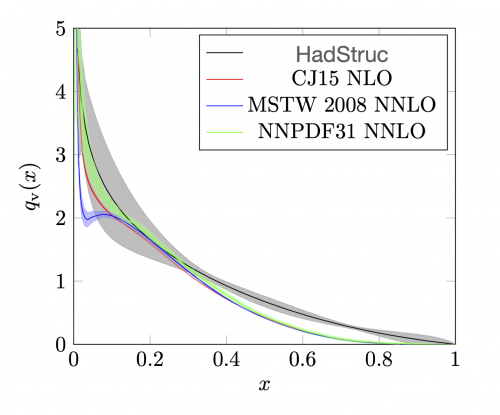Lattice QCD enables the three-dimensional internal structure of hadrons such as the nucleon to be computed from first principles within QCD. The HadStruc Collaboration exploits lattice QCD to calculate the key measures of structure, such as the one-dimensional parton distribution functions (PDFs) and form factors, and the three-dimensional measures such as the generalized parton distributions that encapsulate the femtography of hadrons, and thereby reveal the distribution of momentum, spin and mass amongst the primordial quarks and gluons. Their recent calculation of the valence PDF of the nucleon is shown in the figure, together with comparison with phenomenological determinations from experimental data, including that of the CTEQ-Jefferson Lab (CJ) Collaboration. A further activity is the calculation of the essential QCD effects needed to interpret experiments in nuclear and high-energy physics, such as the LHC and DUNE.

Valence quark PDF in the nucleon versus momentum fraction x carried by the quarks, computed by HadStruc, compared with phenomenological determinations to experimental data from an NLO global fit (CJ15), and from NNLO global fits (MSTW and NNPDF3.1) at a scale of 2 GeV.
HadStruc capitalizes on the world-leading expertise in perturbative QCD, computational physics, and high-performance computing at Jefferson Lab, and amongst our national and international collaborators. The calculations demand a range of computational scales from the leadership-class facilities of the exascale era, to the cost-optimized dedicated facilities at Jefferson Lab. We are exploiting new ideas in artificial intelligence and statistical methods to ensure that key physics emerges with the minimum of bias. In our contribution to the Center for Nuclear Femtography, we are working to ensure that experiment and computation can together provide the most faithful description of the internal structure of hadrons.

